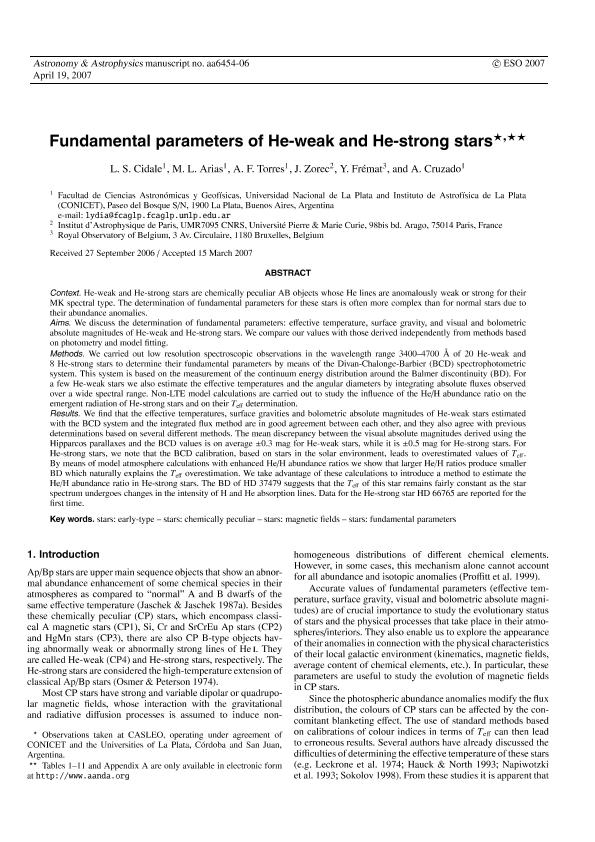Mostrar el registro sencillo del ítem
dc.contributor.author
Cidale, Lydia Sonia

dc.contributor.author
Arias, María Laura

dc.contributor.author
Torres, Andrea Fabiana

dc.contributor.author
Zorec, Juan
dc.contributor.author
Frémat, Y.
dc.contributor.author
Cruzado, Alicia

dc.date.available
2018-04-13T14:59:50Z
dc.date.issued
2007-12
dc.identifier.citation
Cidale, Lydia Sonia; Arias, María Laura; Torres, Andrea Fabiana; Zorec, Juan; Frémat, Y.; et al.; Fundamental parameters of He-weak and He-strong stars; EDP Sciences; Astronomy and Astrophysics; 468; 1; 12-2007; 263-272
dc.identifier.issn
0004-6361
dc.identifier.uri
http://hdl.handle.net/11336/41985
dc.description.abstract
Context. He-weak and He-strong stars are chemically peculiar AB objects whose He lines are anomalously weak or strong for their MK spectral type. The determination of fundamental parameters for these stars is often more complex than for normal stars due to their abundance anomalies. Aims. We discuss the determination of fundamental parameters: effective temperature, surface gravity, and visual and bolometric absolute magnitudes of He-weak and He-strong stars. We compare our values with those derived independently from methods based on photometry and model fitting. Methods. We carried out low resolution spectroscopic observations in the wavelength range 3400–4700 Å of 20 He-weak and 8 He-strong stars to determine their fundamental parameters by means of the Divan-Chalonge-Barbier (BCD) spectrophotometric system. This system is based on the measurement of the continuum energy distribution around the Balmer discontinuity (BD). For a few He-weak stars we also estimate the effective temperatures and the angular diameters by integrating absolute fluxes observed over a wide spectral range. Non-LTE model calculations are carried out to study the influence of the He/H abundance ratio on the emergent radiation of He-strong stars and on their Teff determination. Results. We find that the effective temperatures, surface gravities and bolometric absolute magnitudes of He-weak stars estimated with the BCD system and the integrated flux method are in good agreement between each other, and they also agree with previous determinations based on several different methods. The mean discrepancy between the visual absolute magnitudes derived using the Hipparcos parallaxes and the BCD values is on average ±0.3 mag for He-weak stars, while it is ±0.5 mag for He-strong stars. For He-strong stars, we note that the BCD calibration, based on stars in the solar environment, leads to overestimated values of Teff. By means of model atmosphere calculations with enhanced He/H abundance ratios we show that larger He/H ratios produce smaller BD which naturally explains the Teff overestimation. We take advantage of these calculations to introduce a method to estimate the He/H abundance ratio in He-strong stars. The BD of HD 37479 suggests that the Teff of this star remains fairly constant as the star spectrum undergoes changes in the intensity of H and He absorption lines. Data for the He-strong star HD 66765 are reported for the first time.
dc.format
application/pdf
dc.language.iso
eng
dc.publisher
EDP Sciences

dc.rights
info:eu-repo/semantics/openAccess
dc.rights.uri
https://creativecommons.org/licenses/by-nc-sa/2.5/ar/
dc.subject
Early Type Stars
dc.subject
Chemically Peculiar Stars
dc.subject
Magnetic Fields
dc.subject
Fundamental Parameters
dc.subject.classification
Astronomía

dc.subject.classification
Ciencias Físicas

dc.subject.classification
CIENCIAS NATURALES Y EXACTAS

dc.title
Fundamental parameters of He-weak and He-strong stars
dc.type
info:eu-repo/semantics/article
dc.type
info:ar-repo/semantics/artículo
dc.type
info:eu-repo/semantics/publishedVersion
dc.date.updated
2018-04-09T16:56:19Z
dc.journal.volume
468
dc.journal.number
1
dc.journal.pagination
263-272
dc.journal.pais
Francia

dc.journal.ciudad
Les Ulis, Francia
dc.description.fil
Fil: Cidale, Lydia Sonia. Consejo Nacional de Investigaciones Científicas y Técnicas. Centro Científico Tecnológico Conicet - La Plata. Instituto de Astrofísica La Plata. Universidad Nacional de La Plata. Facultad de Ciencias Astronómicas y Geofísicas. Instituto de Astrofísica La Plata; Argentina
dc.description.fil
Fil: Arias, María Laura. Universidad Nacional de La Plata. Facultad de Ciencias Astronómicas y Geofísicas; Argentina. Consejo Nacional de Investigaciones Científicas y Técnicas. Centro Científico Tecnológico Conicet - La Plata. Instituto de Astrofísica La Plata. Universidad Nacional de La Plata. Facultad de Ciencias Astronómicas y Geofísicas. Instituto de Astrofísica La Plata; Argentina
dc.description.fil
Fil: Torres, Andrea Fabiana. Consejo Nacional de Investigaciones Científicas y Técnicas. Centro Científico Tecnológico Conicet - La Plata. Instituto de Astrofísica La Plata. Universidad Nacional de La Plata. Facultad de Ciencias Astronómicas y Geofísicas. Instituto de Astrofísica La Plata; Argentina
dc.description.fil
Fil: Zorec, Juan. Institut d’Astrophysique de Paris; Francia
dc.description.fil
Fil: Frémat, Y.. Royal Observatory of Belgium; Bélgica
dc.description.fil
Fil: Cruzado, Alicia. Universidad Nacional de La Plata. Facultad de Ciencias Astronómicas y Geofísicas; Argentina. Consejo Nacional de Investigaciones Científicas y Técnicas. Centro Científico Tecnológico Conicet - La Plata. Instituto de Astrofísica La Plata. Universidad Nacional de La Plata. Facultad de Ciencias Astronómicas y Geofísicas. Instituto de Astrofísica La Plata; Argentina
dc.journal.title
Astronomy and Astrophysics

dc.relation.alternativeid
info:eu-repo/semantics/altIdentifier/doi/http://dx.doi.org/10.1051/0004-6361:20066454
dc.relation.alternativeid
info:eu-repo/semantics/altIdentifier/url/https://www.aanda.org/articles/aa/abs/2007/22/aa6454-06/aa6454-06.html
Archivos asociados
